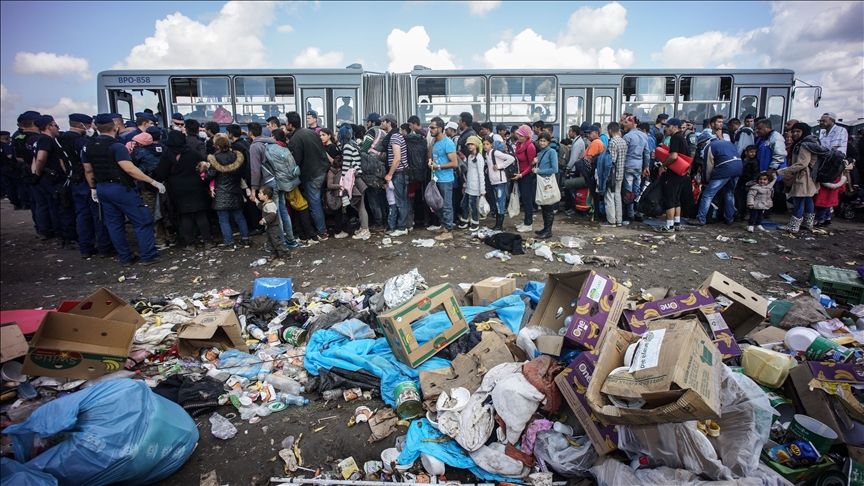

By Anadolu Agency
– At least 9 refugees were killed on Wednesday as their makeshift shelters collapsed in most recent landslide triggered by heavy rain
DHAKA, Bangladesh
The last time Noor Hafsa saw her home being destroyed before her eyes was over six years ago.
It was a night in late August 2017 when soldiers attacked their village in the swampy Maungdaw district of Myanmar’s Rakhine state, killing her husband and many others, and setting fires to dozens of homes, including hers.
Hafsa, then 37, fled with her son and two daughters, enduring a grueling journey through monsoon-soaked jungles and paddy fields in western Myanmar, traveling on foot for three days, often in darkness.
They eventually crossed the border and sought refuge in Cox’s Bazar, an area in southern Bangladesh now recognized as the world’s largest refugee camp.
For years, Hafsa believed her worst days were behind her, but all that has changed.
In the early hours of Wednesday, heavy rain triggered a massive landslide that demolished her makeshift bamboo and tarpaulin shelter in the camp, leaving her homeless and destitute.
Adding to her anguish, one of her daughters suffered severe injuries in the landslide and is fighting for her life.
“I have lost everything. I don’t even know if my daughter will survive,” Hafsa told Anadolu, sitting amid the wreckage of her home in Camp 9 in Ukhia, an area in the Cox’s Bazar district.
“I don’t know how much longer God will test us.”
Constant risks
At least nine people perished as their makeshift shelters collapsed in the heavy rain, drowning them under a deluge of mud and water, just a day before World Refugee Day, marked globally on June 20.
With Bangladesh’s monsoon season far from over, the Rohingya refugees are increasingly vulnerable as they are not allowed to implement measures that could mitigate the devastating impact of frequent landslides and flooding.
About 1.2 million Rohingya have sought refuge in Bangladesh, the majority having fled a brutal 2017 military crackdown that involved rape, murder and widespread arson, and has been condemned as ethnic cleansing by international organizations.
They face a constant reminder of their vulnerability as the government of the South Asian nation has prohibited the construction of durable shelters designed to endure both the yearly monsoon and frequent dry-season fires.
Data from Bangladesh’s Refugee, Relief and Repatriation Commissioner office reveals that landslides in Rohingya refugee camps have tragically claimed at least 83 lives over the past five years.
Additionally, these landslides have destroyed over 30,000 tarpaulin and bamboo homes, displacing a significant number of refugees.
A 2021 report by Human Rights Watch pointed out that humanitarian agencies have repeatedly warned that shelters made of bamboo and tarpaulin leave the inhabitants in danger.
“But the Bangladesh authorities have refused to let the agencies build any permanent structures that can be used as schools and double up as evacuation shelters in an emergency,” said the report.
In 2017, to accommodate the influx of Rohingya refugees, over 7,220 hectares (nearly 17,850 acres) of forests and hills were cleared, leaving the area vulnerable to natural disasters.
The removal of hills, which are essential for absorbing rainwater, has led to an increased frequency of landslides.
Furthermore, extensive deforestation and excessive groundwater extraction for the refugees have lowered the water table, exacerbating the risk of landslides and sinkholes, according to Mohammad Shamsud Douza, the additional refugee, relief and repatriation commissioner in Bangladesh.
He told Anadolu that the government has prohibited any permanent structures in the camp because it is situated in an ecologically critical area.
“Besides, these Rohingya refugees are not here permanently. They are citizens of Myanmar and we are trying to send them back,” he added.
Failed repatriation attempts
Multiple official repatriation efforts by the Bangladesh government, however, have been unsuccessful due to persistent fears among refugees that they would face oppression and abuse in Myanmar.
Azeem Ibrahim, author of The Rohingyas: Inside Myanmar’s Genocide, highlighted the dire situation for Rohingya repatriation, saying there is “nowhere for the Rohingya to return to.”
He pointed to Myanmar’s decades-long effort to expel them, culminating in their forced displacement and the mining of the border to prevent their return.
Regarding the 2021 coup that ousted Aung San Suu Kyi’s government, he told Anadolu that the Myanmar military’s subsequent disregard for international opinion “further diminishes the prospects of a safe and dignified return for the Rohingya people.”
Abdur Rahim, leader of the Arakan Rohingya Society for Peace and Human Rights, expressed dismay at the living conditions of the Rohingya in the refugee camps.
“We can’t build any strong structure that can withstand heavy rain,” Rahim told Anadolu.
“Inside the barb-wired camp, there is no scope of getting any jobs. This is not the life that we want.”
Rahim said the refugees long for their homeland, but they fear that the situation in Myanmar remains unsuitable for their return, something that international institutions such as the UN have also recently pointed out.
“With the Myanmar military in power and civil war ongoing, we cannot be safe there,” he said.
We use cookies on our website to give you a better experience, improve performance, and for analytics. For more information, please see our Cookie Policy By clicking “Accept” you agree to our use of cookies.
Read More